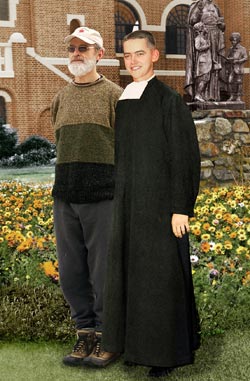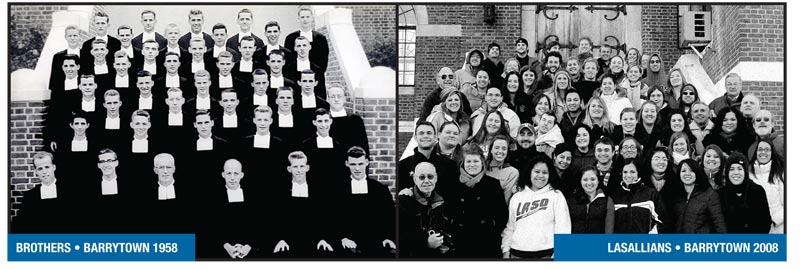For some time, Lasallians have published statements and chapter documents beginning with the words:
“We Lasallians, Brothers and Partners…”
It’s a way of expressing unity of all Lasallian workers for the mission of human and Christian education to the young, especially the poor, and it uses an appositive to divide all Lasallians into Brothers or Partners.
But why not some other appositive like “women and men” or “Sisters and Brothers” or “old and young” or “professors and instructors?”
To use “Brothers and Partners” cannot be an effort to name significant numerical sub groups of Lasallians. Across the world today, these two groups of Brothers and Partners are currently 3% and 97% respectively.
Likewise, it cannot be about a special skill to effect the mission that one group has over the other. Both equally achieve the mission. It cannot be some special sacramental character or mark of distinction that separates these Lasallians in any way. Brother Álvaro has often pointed out the baptismal equality of all Lasallians, and he has made it clear that there are no second class citizens here. Recently, he wrote in his pastoral letter for the end of 2012:
“As Brothers, we are called to be the sacrament of the horizontal dimension in the Church for the life of the world, the human and compassionate face of the Church…”
Given these words, the term “Brothers and Partners” appears as a dichotomy — two mutually exclusive or contradicting groups. No Lasallian can belong to both at the same time. Can we say these two sub groups are “separate but equal?” History of the United States alone proves that separate is never equal.
On December 7, 1958 — in small upstate Barrytown, New York — 39 young men posed for a photo as they began their time of spiritual preparation for their Lasallian mission. These young men (all recent graduates of high school) were excited to be able to call each other “Brother” — especially the one right of center on the top row. On that day across the world, Brothers and Partners were close to 45% and 55% of the Lasallian family respectively. In 2008 (50 years later) 55 young men and women (all recent graduates of college) posed on those same steps as they too prepared for their work in the Lasallian mission. They called each other “Lasallian Volunteers.”
Those aware of the declining numbers of religious Brothers over the past 50+ years (and the aging of current members) glance at the contrast of these two photos and are tempted to conclude that men and women “Partners” have all but replaced Brothers in the Lasallian mission.
Serving Needy Schools, Brothers and Sisters of the 21st Century, a recent article in The New York Times, also contributes to this understanding. The article described a group of Notre Dame sponsored ACE volunteers — much like the Lasallian equivalent — who live in Tucson, AZ, and work in area Catholic schools.
“Devoting themselves to society’s overlooked and left-behind,” says author Samuel Freedman, “and living in intentional Christian households, the 1,600 teachers produced by ACE in its 19-year history have formed the 21st century equivalent of the Sisters and Brothers from Catholic religious orders whose sacrifices for decades sustained the American parochial school system.”
Even with the recognition of the contribution of so many religious over the years, this language of replacement can lead to resentment and misunderstanding — especially by those who consider themselves replaced. It lends itself to a dualism, an either/or, and even competitive view of the Brother/Partner roles.
Fear of being replaced makes some Brothers want to hold on to the appositive even more. In highlighting the contribution of Partners, there is no need to talk “replacement.”
Some of these considerations over the years have encouraged older Lasallians — especially some Brothers — to abandon their effort to accommodate to unrelenting change in favor of wanting the safety and security of some distant day in the past. They forget that all creation myths begin with chaos, crisis and pain before something new emerges. They wish for the Lasallian family to be as it was in 1958. They suffer from what Richard Rohr calls “regressive restoration of persona.” Riding a bike or car into the rising sun in early morning can be blinding, but one can have total clarity looking in the rear view mirror.
Over the past 50+ years, God has spoken in the events of our time and has lead us into that sacred chaos that has only one way out — into a new future unknown to any of us today.
We, like the Israelites in the desert, cannot return to Egypt. We must look forward to whatever God has in store for us. We must embrace the future with open arms.

Ed Phelan posing at Barrytown in 1958 and 2008
Today, our task is to put aside our ego differences, dissolve many of the distinctions that make us want to be “Brothers and Partners,” and focus on what unites us for the benefit of children and their families across the world. We are Lasallians. We can be one ever-expanding Lasallian family, acting together to change the world. One La Salle.
At last count, 78,000 Lasallians were serving over a million students and families across the world. Add to this vast group of Lasallians: Brother alums who continue their involvement in the mission; retired Partners and Brothers; Lasallian youth and collegians; Young Lasallians; Lasallian Volunteers; members of the St. La Salle auxiliaries; and all who support this effort with energy, money and prayer. This Lasallian family is bigger than ever.
One local group in the process of change on this issue is the District of Eastern North America (DENA). Once a designation of Brothers only, this entity today has a broad new vision for itself as a Lasallian association incorporating all of the aforementioned groups into a powerful force to bring change into the lives of children and families. While still using the appositive, they use the word “Lasallian” twice as often as either Brother or Partner. They are embracing a future not hanging onto a past.
“We, Lasallians of the District of Eastern North America, Brothers, Associates and Partners,” says the DENA vision statement, “recognize in the words of our Founder the wondrous actions of the most Holy Trinity in calling each of us individually and all of us together to the mission entrusted to us.
The Times Are a Changin’
On their website, lasalle.org, the worldwide Lasallian Center or Motherhouse in Rome makes little mention of “Brothers and Partners.” Instead they call the site “the Lasallian Family Portal” and use the word “lasallian” throughout.
Progress since 1958 for the Lasallian family is due to the way it has engaged the modern world. New ways of thinking and operating have enabled the family to welcome change and pull together. We have made our own what John O’Malley wrote in describing how Vatican II moved Christians to a new vision of the church:
“…from commands to invitation, from laws to ideals, from definition to mystery, from threats to persuasion, from vertical to horizontal, from exclusion to inclusion, from suspicion to trust.”
The family is vibrant and alive across the world. Students represent all religions; women number over 50% of teachers and staff; association has been rediscovered; new models of collaborative leadership have been discovered; new structures of education have emerged; the Lasallian vocation has been discovered anew; formation opportunities abound; and family members face the future confident in the God who leads and cares and loves.


Leave A Comment